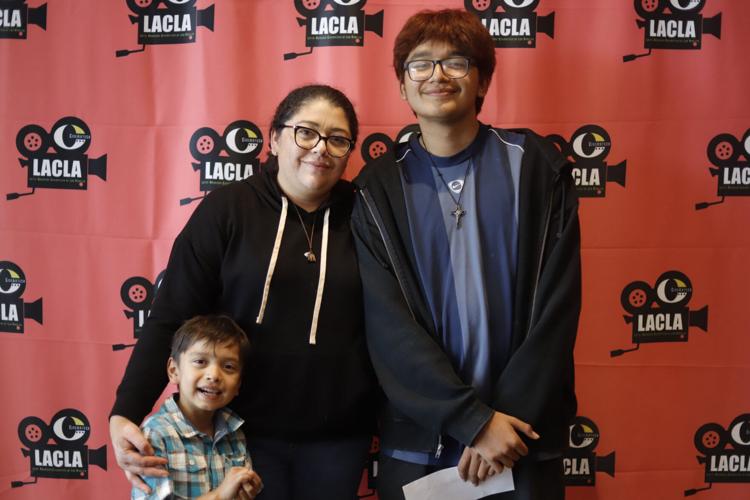
Kevin Amaya, right, who won first place for his film "Grief," poses with his mother Idalia, center, and younger brother Oliver. (Photo by Gisselle Palomera)
The Latin American Cinemateca of Los Angeles (LACLA) recently hosted its 14th Annual student film festival, spotlighting films made by middle and high school students, with a record-breaking 641 film submissions.
Out of hundreds of submissions, twenty short films were chosen to be showcased at Cathedral High School where the film festival took place, representing the San Fernando Valley to South Los Angeles and from East Los Angeles to Venice.
The LACLA Student Film Festival spotlighted the talented, relevant and dynamic stories of underrepresented and low-income youth. An overwhelming majority of the film's themes centered around grief, struggles, social anxieties and the overwhelming pressure to perform in academics.
“This [film festival] gives students a voice,” said Melina Rodriguez Kater, festival director. “We put so much merit on how good they’re doing in school but I think that the fact that we had so many submissions that had to do with mental health and struggles and insecurities, makes me realize that these kids are screaming for us to pay attention [to their struggles.]”
According to the National Alliance on Mental Illness, 50 percent of lifetime mental illness begins by age 14, with75 percent by age 24. NAMI also points out that high school students with significant symptoms are more than twice as likely to drop out, compared to their peers.
LACLA’s student programs are designed to boost their confidence and guide them on a path to career opportunities, while also providing them with an outlet to cope with anxiety, depression and even loss.
“Grief,” winner of the first place award, is a touching story of a young teen who deals with the loss of his mother. In the film, the young boy played by Kevin, loses his mother to cancer. She leaves behind a letter with her last words to him, which he refuses to read.
When he finally brings himself to read the letter, it’s read in the mother’s voice. “I’m so proud of you,” she writes. “I want you to be happy.”
The screening of “Grief” filled the Richard A. Grant theater with the sound of sniffling and faint whispers.
“I have a friend who lost his life and it was hard for me to cope with it and I wanted to show what I was going through at the time,” said Kevin Amaya, 17, student at Alliance Collins Family College Ready High School, and director of “Grief.”
“There is a scene in [Grief] where I’m crying and I really needed to let that out to show the audience that this is how it really feels and looks,” said Kevin.
Kevin’s mother, Idalia Amaya, attended the film festival and watched as her son accepted the first place award in front of an audience that applauded enthusiastically for his accomplishments.
“For Kevin, this film was an outlet for him to let out all the pain he was feeling,” said his mother in Spanish. “I feel so proud of him for showing his roots [in the film] and representing Latin Americans.”
His mother says she was astounded to see that he directed a film starring him as a Salvadorian teen struggling with grief that was so universal and touched on such a deep subject.
The film that won the Most Creative Award at the festival dealt with another deep subject, but handled in a satirical way. “Hair Of Its Own,”written, directed and animated by Lazayah Lannigan, 19, from Van Nuys High School, features a young teen and a personified version of her textured hair.

Lannigan's animation of her hair, a still from her film "Hair Of Its Own," 2024. (Photo credit: Lazayah Lannigan)
The four-minute film begins with her daily attempt to straighten and tame her hair, but as the film progresses, she is shown to begin embracing it and learning to work with it, rather than killing it with hair products and intense heat. The film won the Most Creative Award because of Lannigan’s use of animation to personify the struggle with her hair.
The Public Service Announcement Award went to “Beyond The Surface,” a one-minute deep-dive directed by Kyan Whiten, 17, from Los Alamitos High School, showing personal battles and facing struggles that are more than skin deep.
Chosen as the runner-up for first prize was “A Fading Canvas,” a three-minute short film about grief and coping with the loss of a family member directed by Angela Huang, 16, from Orange County School of the Arts. Angela loses her passion for painting after her grandmother passes away, The film explores themes of grief and recovery in the background of nostalgic scenes of them painting together.
“I really think these voices and stories are so necessary to hear,” said Vera Amaya, film festival judge and filmmaker. As a bi-racial, Latina and Asian filmmaker, she advocates for more funding to be directed towards creative programs like this one to ensure resources are available for historically underrepresented youth. Amaya is a former student director for LACLA, who hosted the festival online during the COVID-19 pandemic.

Portrait of Lazayah Lannigan, 19, representing Van Nuys High School. (Photo credit: Lazayah Lannigan)
“We have to have blind faith in our craft to make [these resources] accessible,” said Amaya. “Being able to uplift other young filmmakers who maybe don’t know how to share their voice, using multiple mediums to make [films], is extremely powerful.”
The LACLA Student Film Festival is currently funded by the Los Angeles County Department of Arts and Culture and the Diaz-Martinez Family Foundation. Funding ensures that nonprofits like LACLA are able to continue providing resources for students to share their voice and to have an outlet to express their grief and anxieties.
Michael Diaz, president of Latin American Cinemateca of Los Angeles, says he believes one of the biggest issues this program is currently facing is a lack of funding.
“Many [prospective] donors don’t take into consideration arts programs like this,” said Diaz. “Without funding, this program cannot continue.”
According to the California Arts Council, low-income students who are highly engaged in the arts are more than twice as likely to graduate college in comparison to peers with no arts education. Arts programs such as LACLA provide resources for low-income and traditionally underrepresented youth, both groups with a high drop-out rate. Low socio-economic status students with a high participation in the arts have a four percent dropout rate, in comparison to 22 percent experienced by students who do not participate in arts programs.
“This [film festival] is a real and true window into what these students are thinking and feeling, so we need to listen to them,” concluded festival director Rodriguez Kater.















(0) comments
Welcome to the discussion.
Log In
Keep it Clean. Please avoid obscene, vulgar, lewd, racist or sexually-oriented language.
PLEASE TURN OFF YOUR CAPS LOCK.
Don't Threaten. Threats of harming another person will not be tolerated.
Be Truthful. Don't knowingly lie about anyone or anything.
Be Nice. No racism, sexism or any sort of -ism that is degrading to another person.
Be Proactive. Use the 'Report' link on each comment to let us know of abusive posts.
Share with Us. We'd love to hear eyewitness accounts, the history behind an article.